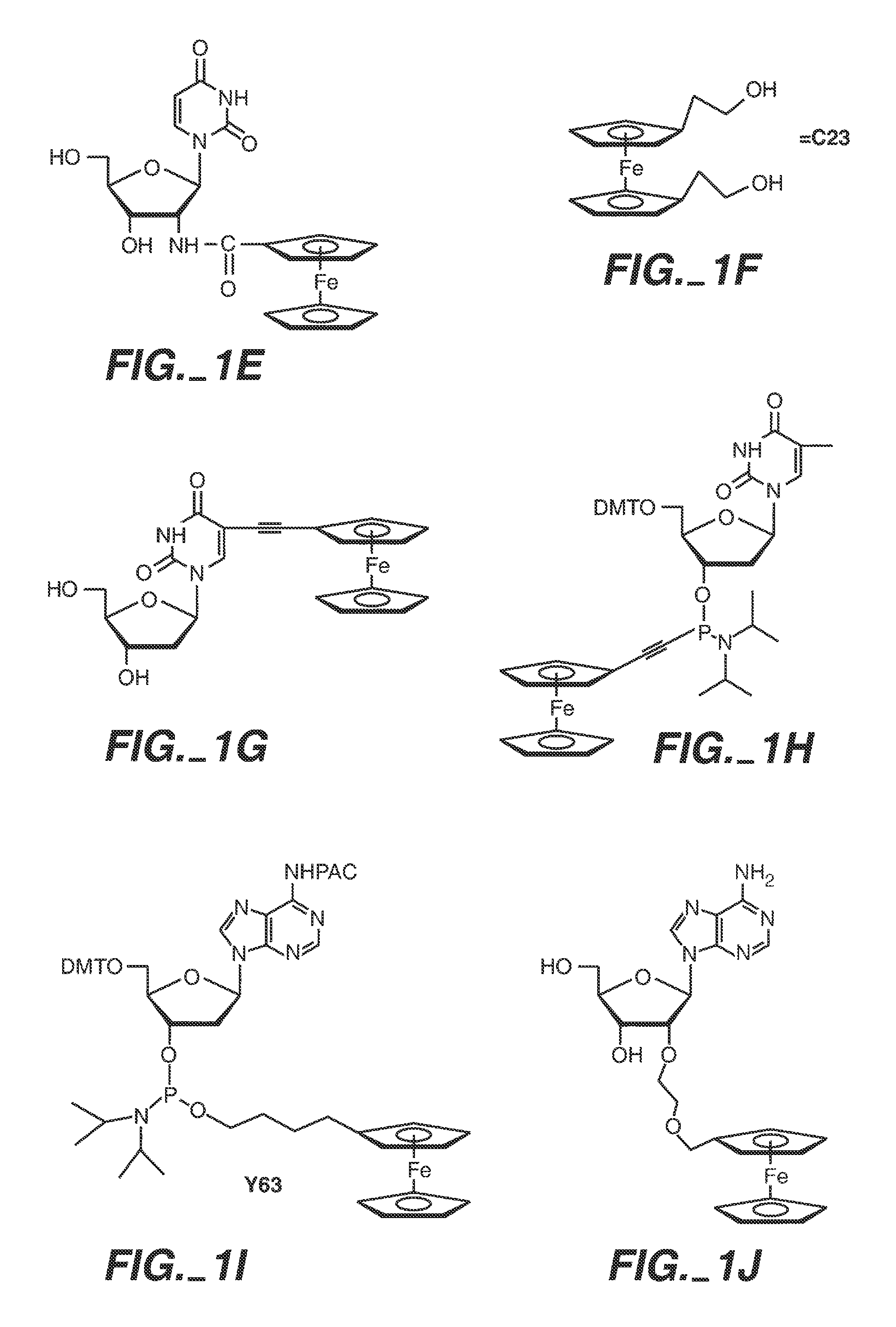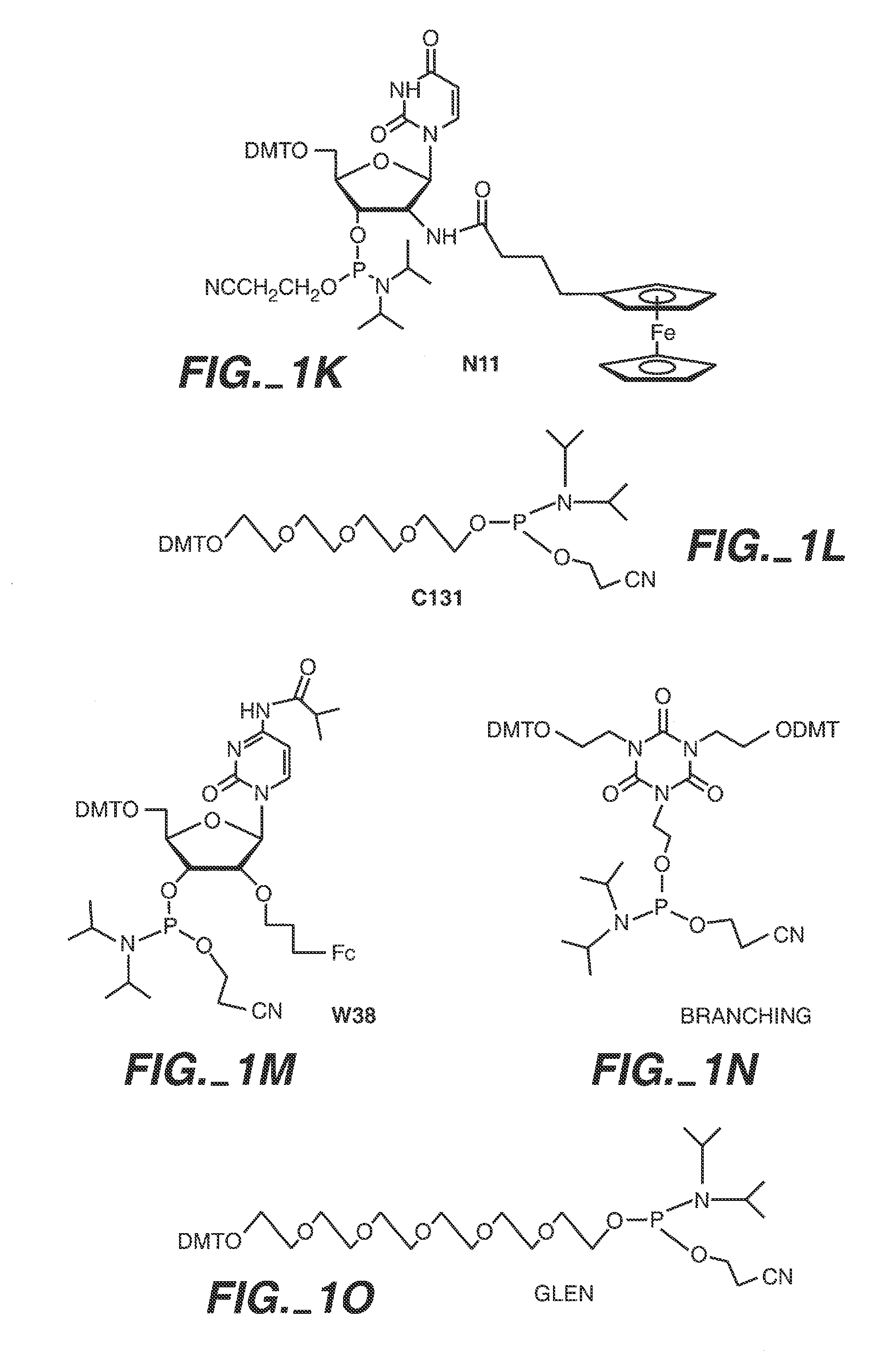Sequence determination of nucleic acids using electronic detection
a technology of electronic detection and sequence determination, applied in the direction of instruments, biochemistry apparatus and processes, material analysis, etc., can solve the problems of general use difficulty, specificity, and in contrast, remain problems
- Summary
- Abstract
- Description
- Claims
- Application Information
AI Technical Summary
Benefits of technology
Problems solved by technology
Method used
Image
Examples
example 1
General Methods of Making Substrates and Monolayers
SAM Formation on Substrates—General Procedure
[0563]The self-assembled monolayers were formed on a clean gold surface. The gold surface can be prepared by a variety of different methods: melted or polished gold wire, sputtered or evaporated gold on glass or mica or silicon wafers or some other substrate, electroplated or electroless gold on circuit board material or glass or silicon or some other substrate. Both the vacuum deposited gold samples (evaporated and sputtered) and the solution deposited gold samples (electroless and electroplated) often require the use of an adhesion layer between the substrate and the gold in order to insure good mechanical stability. Chromium, Titanium, Titanium / Tungsten or Tantalum is frequently employed with sputtered and evaporated gold. Electroplated nickel is usually employed with electroplated and electroless gold, however other adhesion materials can be used.
[0564]The gold substrate is cleaned pr...
example 2
The Use of Temperature and Competimers to Determine Sequence
[0580]The ability to discriminate single nucleotide polymorphisms (SNPs) is an important goal. We tested for the ability to discriminate single nucleotide mutations in the Hereditary Hemochromatosis gene (HFE), in which an abnormal protein product results in iron overload. We first established a sandwich assay for mismatch detection in the surface probe binding domain of the target. The 76-mer oligonucleotide model sequence for HIV served as the initial target and subsequently model oligos mimicking HFE amplicons were used. Finally we tested asymmetric PCR (A-PCR) products from HH (hereditary hemochromatosis) patients to confirm the utility of arrayed sandwich assays to genotype patient samples with respect to two prevalent mutations. We also developed a model OLA assay that reveals our ability to detect a single backbone bond cleavage.
Discrimination of Point Mismatch in HIV or HFE 76 bp Model Oligos within the Surface Prob...
example 3
Genotype Determination of Hereditary Hemochromatosis by Detecting Single Nucleotide Mismatch in Asymmetric PCR (A-PCR) Products
[0593]Purpose: To confirm that the sandwich assay that was developed for mismatch detection of HFE model targets can be used to detect the same mutation in A-PCR product.
[0594]Introduction Hereditary Hemochromatosis is the most prevalent identified inheritable disease. HH often goes undiagnosed and is frequently the root cause of many metabolic disorders.
[0595]The most common mutation of HH is a cysteine-to-tyrosine mutation at position 282 (C282Y mutation), resulting from a guanine-to-adenine transition. PrimerF1_C and PrimerR1_C, listed in Materials and Methods, were originally designed for PCR diagnosis of the HH mutation at 282. The original method uses this primer pair to amplify a 388 bp fragment by PCR and genotype is determined by subsequent Rsa I restriction digestion and agarose gel electrophoresis. The mutated PCR product has an extra Rsa I site a...
PUM
| Property | Measurement | Unit |
|---|---|---|
| Tm | aaaaa | aaaaa |
| temperatures | aaaaa | aaaaa |
| temperatures | aaaaa | aaaaa |
Abstract
Description
Claims
Application Information
 Login to View More
Login to View More - R&D
- Intellectual Property
- Life Sciences
- Materials
- Tech Scout
- Unparalleled Data Quality
- Higher Quality Content
- 60% Fewer Hallucinations
Browse by: Latest US Patents, China's latest patents, Technical Efficacy Thesaurus, Application Domain, Technology Topic, Popular Technical Reports.
© 2025 PatSnap. All rights reserved.Legal|Privacy policy|Modern Slavery Act Transparency Statement|Sitemap|About US| Contact US: help@patsnap.com



